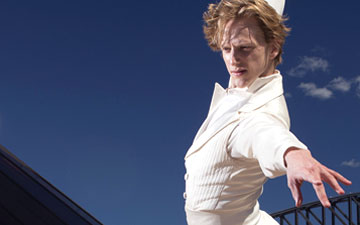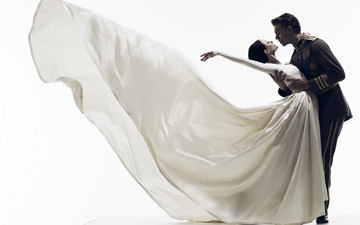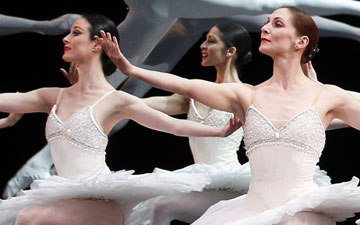
© Jeff Busby. (Click image for larger version)
Australian Ballet
Cinderella
★★★✰✰
London Coliseum
20 July 2016
Gallery of pictures by Foteini Christofilopoulou
australianballet.com.au
When Alexei Ratmansky revised his Bolshoi Cinderella (2002) for The Australian Ballet in 2013, he and his French designer, Jerome Kaplan, decided to restage it as Surrealist fantasy rather than a happy-ending romance. Prokofiev’s dark, acerbic score with its mesmerising waltzes is ill-suited to a fairy tale ballet. It does, however, prescribe how the story unfolds. On the first night in London, Nicolette Fraillon, The Australian Ballet’s music director, emphasised the quirkiness of Ratmansky’s options as she conducted English National Opera’s Orchestra.
Cinderella’s mismatched family lives in a derelict theatre, like Cubans inhabiting abandoned colonial buildings. Though Father is a feckless drinker, there appears to be enough money to kit out Stepmother and daughters in finery for a royal ball. They are extravagant in all aspects, including their dancing. The two Stepsisters (Ingrid Gow and Eloise Fryer) are balletic monsters, distorting their steps, prone to prat-falls. Stepmother (Amy Harris), apparently the same age as her daughters, is glamorous and venomous. Funny they are not.

© Foteini Christofilopoulou. (Click image for larger version)
Leanne Stojmenov’s Cinderella is far from down trodden. Left alone, she is spirited and imaginative, cheering herself up with sparky jumps and speedy runs on pointe. Ratmansky’s choreography for his heroine is even bendier than Ashton’s, pulling the dancer off-balance, requiring swift changes of direction as the next whim overtakes her. Stojmenov makes her reactions to the music seem spontaneous, as though day-dreaming of an alternative life. When she is momentarily wistful, mourning her dead mother, a Fairy Godmother (Jasmin Durham) materialises to make her dream of going to the ball come true.
The Godmother apparition is more of a goblin than a fairy, dressed in a shabby overcoat, specs and a Magritte bowler hat, with a Pinocchio nose. She remains the same throughout, perhaps fulfilling her fantasy through Cinderella of being accepted by high society. She summons celestial bodies to transport Cinderella to the royal palace. The Seasons’ music variations go to unisex figures in puffball tutus representing eccentric planets and stars. Kaplan and Ratmansky indulge their wildest fancies, disfiguring dancers in grotesque costumes. Even worse, the quixotic choreography disintegrates into a gallimaufry of frolicking to Prokofiev’s haunting waltz. Abruptly, black clad creatures clutching Roman numerals surround Cinders in her splendid party frock to warn her of a midnight curfew.

© Foteini Christofilopoulou. (Click image for larger version)
The rock star Prince lives in a palace of malachite pillars and pink drapery. His guests, all attired in ‘pant suits’, are energetic extraverts, showing off the latest moves. Ratmansky cleverly juxtaposes different groups at different heights, using the corps as a disciplined social tribe into which the step-family intrude as hoydens ignorant of the dress code and the choreography. Still not funny. The prince makes a big entrance, heralded by four dashing male companions. The prince (Kevin Jackson) is yet another ballet monster, displaying his repertoire of flashy virtuoso steps in a gleaming white suit.
Cinders’ arrival is pure fantasy. All alone on the stage, she is very pleased with herself, fist-pumping the air as she dances in glee in her New Look ball dress. She is ignored by the returning guests until the prince intervenes, entranced. She lives the dream of being swept off her feet by Prince Charming in an instantly attuned partnership. Curiously, she and the prince need to converse with each other in hand signals, choosing to withdraw together.
Time is elastic, so the guests have had no problem in securing alternative flouncy frocks to keep up with Cinderella’s. Her step-sisters are, of course, out of step with the sudden change in fashion. Cinders, who up till now has been an eloquent ballerina, performs a gauche little dance, embarrassing herself until the besotted prince joins her. He obligingly performs his own show-off solo before running off with her into the palace garden.

© Jeff Busby. (Click image for larger version)
Their pas de deux beneath a full moon becomes ecstatic, their steps synchronised in harmony with each other, their swooping lifts rapturous. It’s a long, well-sustained duet, briefly interrupted by the prince’s companions and waltzing couples. Surrealism returns with mobile topiary bearing a single eye on a Magritte metronome instead of a ticking clock. When the moon tells of midnight, nobody, not even the reformed prince, recognises drab Cinders. A faithful old retainer clutches her cast-off shoe.
Ratmansky can’t deal with Prokofiev’s round-the-world music for Act III (wisely cut by Ashton). He ignores its galloping rhythms in favour of flailing moves for the frantic prince in front of projected sequences of eyes, shoes and antiquated modes of transport. The prince, who must be hallucinating, is barely tempted by male and female sirens before the scenery reverts to Cinders’ dilapidated home. There the silly step-trio squabble and compete over the non-fitting slipper until Cinderella reveals its companion. She is finally acknowledged as the potential princess. Her family is reconciled, including rehabilitated father, though we can’t care much for any of them.
Cinderella and Prince Charming are transported to the palace, illuminated by stars and planets, for an even more ecstatic pas de deux, complete with vertiginous lifts, as the music slows and sweetens. In the closing moments, the prince lies at Cinderella’s knees, rescued and humbled, no longer a vainglorious rock star. The good-hearted girl has got her man. The message doesn’t really chime with Surrealism’s arbitrariness: the production lurches between down-to-earth Aussie niceness and the designer’s European conceits. All the same, the treatment is colourful and surprising, its cartoon-like gags contrasted with emotionally expressive pas de deux. Ratmansky uses a varied neo-classical ballet vocabulary so fluently that it’s disappointing when he fails to reflect Prokofiev’s complex rhythms in ensemble set-pieces.

© Foteini Christofilopoulou. (Click image for larger version)
The Australian Ballet’s dancers make the most of their roles, though only Cinderella is enabled to reveal different aspects of her personality, transformed from feisty girl to fulfilled lover. Stojmenov was charm personified, subsuming technique (and naturalistic stomping around) into unforced responses to the music and her princely partner. Jackson made the brash prince into a Mr Darcy figure, tamed by his sensible, albeit highly romantic wife-to-be. The antics of the stepfamily in their garish outfits raised some laughs, fortunately for the dancers, though scarcely in my area of the auditorium. Good to see senior former dancers – Stephen Heathcote as Father, Franco Leo as the old retainer – in mildly comic roles. Sympathy for those encumbered with heavy, misshapen costumes as planetary forces or Godmother clones.

















Jerome Kaplan’s metronome topiary is based on Man Ray’s ‘Indestructible Object’, a version of which is in the Tate but apparently not on display. My mistake in attributing the original concept to Magritte.